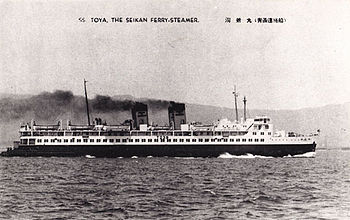Tōya Maru
This article needs additional citations for verification. (September 2009) |
 Toya Maru at an unknown date
| |
| History | |
|---|---|
| Name | Tōya Maru |
| Owner | Japanese National Railways |
| Port of registry | |
| Builder | Mitsubishi Heavy Industries, Kobe, Japan |
| Yard number | 816 |
| Launched | 21 November 1947 |
| In service | 1948 |
| Out of service | 26. September 1954. |
| Fate | Sank during a typhoon in the Tsugaru Strait between the Japanese islands of Hokkaidō and Honshū on 26 September 1954 |
| General characteristics | |
| Class and type | RO/RO ferry |
| Tonnage | 3,898 grt (11,040 m3) |
| Length | 118.7 m (389 ft) |
| Beam | 15.85 m (52.0 ft) |
| Speed | 20 knots |
| Capacity | 1,128 passengers |
| Crew | 120 crew |
Tōya Maru (洞爺丸) was a Japanese train ferry constructed by Japanese National Railways (JNR) which sank during a typhoon, later known locally as the Tōya Maru Typhoon,[1] in the Tsugaru Strait between the Japanese islands of Hokkaidō and Honshū on September 26, 1954. JNR announced in September 1955 that 1,153 people aboard were killed in the accident. However, the exact number of fatalities remains unknown because there were victims who managed to obtain passage on the ship at the last minute, and others who cancelled their tickets just before the incident occurred.
Construction[]
Tōya Maru was launched on November 21, 1947. She was 118.7 m (389 ft) long and 15.85 m (52.0 ft) at her beam and she had a gross register tonnage of 3,898 grt (11,040 m3). She could accommodate 1,128 passengers and was operated by a crew of 120. She covered the distance from Aomori to Hakodate in 4 hours and 30 minutes.
As early as 1950, she was fitted with radar equipment, becoming one of the first Japanese sea liners to be so equipped. She was used by the Emperor the month before she sank. She was also famous as the flagship of the Tsugaru Strait.
Accident[]
See also[]
References[]
- ^ "洞爺丸台風 昭和29年(1954年9月24日~9月27日" (in Japanese). Japan Meteorological Agency. Retrieved September 28, 2018.
External links[]
| Wikimedia Commons has media related to Tōya maru. |
- Miramar Ship Index (in English)
- Merchant ships of Japan
- Shipwrecks in the Pacific Ocean
- Seikan Tunnel
- 1947 ships
- Ferries of Japan
- Train ferries
- Ships built by Mitsubishi Heavy Industries